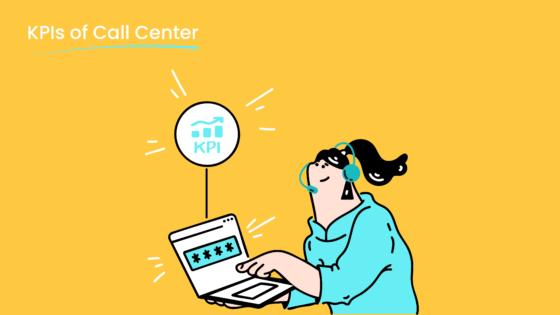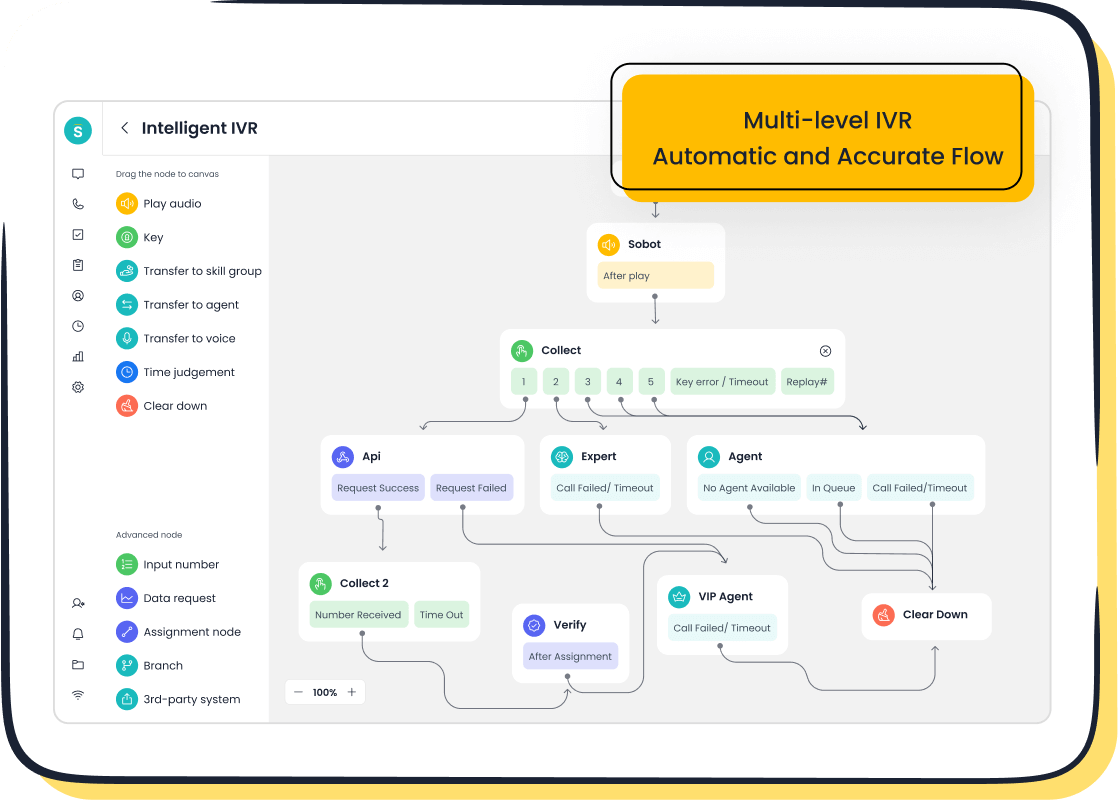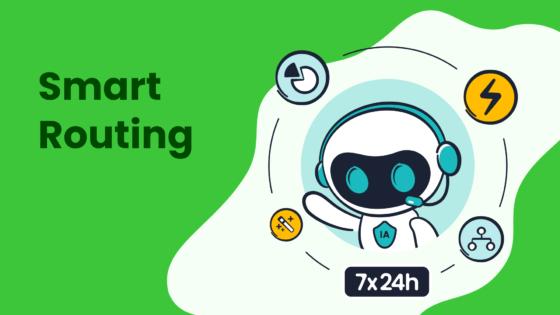15 Key Indicators for Outstanding Customer Service

In 2025, delivering exceptional customer service demands more than intuition—it requires precise measurement. Key performance indicators for customer service act as your compass, guiding your team toward excellence. Companies that embrace these metrics see significant transformations. For instance, a 5% boost in customer retention can drive profits up by 25% or more, highlighting the financial value of satisfied customers. On the flip side, poor service costs U.S. businesses $75 billion annually. Tools like Sobot’s all-in-one solutions empower you to track, analyze, and act on these KPIs, creating seamless customer experiences while improving operational efficiency.
"The only path to profitable growth may lie in a company's ability to get its loyal customers to become, in effect, its marketing department." – Fred Reichheld
Understanding Key Performance Indicators for Customer Service
Definition and Role of Customer Service KPIs
Key performance indicators for customer service are measurable values that help you evaluate the effectiveness of your support strategies. These metrics provide insights into how well your team meets customer expectations and identifies areas for improvement. For example, First Contact Resolution Rate measures the percentage of issues resolved during the first interaction, while Average Handle Time tracks how long it takes to address a query. These KPIs ensure you focus on what matters most—delivering exceptional customer experiences.
Real-world examples highlight their importance. A company like Samsung improved its customer satisfaction rate to 97% by leveraging KPIs such as resolution time and agent efficiency. By tracking these metrics, you can align your team’s efforts with your business goals, ensuring consistent and high-quality service.
Why KPIs Are Crucial for Measuring Success
Customer service KPIs act as a roadmap for success. They help you identify trends, measure progress, and make data-driven decisions. For instance, tracking Customer Satisfaction (CSAT) scores allows you to gauge how happy customers are with your service. When paired with tools like Sobot’s AI-powered analytics, you can uncover patterns and adjust strategies to improve outcomes.
Effective KPI tracking also strengthens the link between quality assurance and performance metrics. Companies that align QA metrics with KPIs often see higher customer satisfaction. Continuous feedback loops and data analysis ensure your team stays on track, leading to better decision-making and improved results.
Industry-Specific Variations in Customer Service KPIs
Different industries prioritize unique KPIs based on their goals. In retail, metrics like Conversion Rate and Shopping Cart Abandonment Rate are critical. Financial services focus on Onboarding Time and digital adoption rates. Healthcare emphasizes Wait Time and patient satisfaction scores. The table below illustrates these variations:
| Industry | KPI | Example of Improvement |
|---|---|---|
| Retail | Conversion Rate | Target improved by 12% through app optimization. |
| Shopping Cart Abandonment Rate | Reduced by 8% with personalized discounts. | |
| Financial Services | Onboarding Time | Fidelity reduced by 20%, increasing satisfaction by 15%. |
| Healthcare | Wait Time | Cleveland Clinic improved by 25%, leading to 20% satisfaction increase. |
| Telecommunications | Customer Effort Score (CES) | Verizon improved by 18%, leading to a 12% increase in NPS. |
Understanding these variations helps you tailor your customer experience KPIs to your industry’s needs. Sobot’s omnichannel solutions, for instance, enable you to track and optimize these metrics across multiple platforms, ensuring seamless service delivery.
Customer Satisfaction Metrics

Customer satisfaction metrics are essential for understanding how well your business meets customer expectations. These metrics provide actionable insights, helping you refine your strategies and deliver exceptional experiences. Let’s explore three key metrics that define outstanding customer service.
Customer Satisfaction Score (CSAT)
The customer satisfaction score (CSAT) measures how happy customers are with a specific interaction or service. It’s calculated by asking customers to rate their experience on a scale, typically from 1 to 5. A higher score indicates greater satisfaction.
For businesses aiming for excellence, an 80% CSAT score is considered the gold standard. Companies achieving this benchmark often see increased loyalty and repeat business. For example, Samsung, using Sobot’s omnichannel solutions, achieved a 97% satisfaction rate by streamlining communication and resolving issues faster.
| Metric | Benchmark Range | Excellent Score | Average Score |
|---|---|---|---|
| CSAT | 80% (gold standard) | 80%+ | 15% |
Sobot’s AI-powered tools, such as its unified workspace and chatbots, simplify the process of gathering and analyzing CSAT data. These tools enable you to identify pain points and implement targeted improvements, ensuring your customers remain satisfied.
Tip: Regularly monitor your CSAT scores to identify trends and address issues before they escalate.
Net Promoter Score (NPS)
The Net Promoter Score (NPS) evaluates customer loyalty by asking a simple question: “How likely are you to recommend our service to others?” Customers respond on a scale from 0 to 10, with scores grouped into promoters (9-10), passives (7-8), and detractors (0-6).
An NPS above 70 is considered excellent and reflects strong customer loyalty. Businesses with high NPS scores often benefit from word-of-mouth referrals and reduced churn. For instance, proactive support strategies, like those enabled by Sobot’s omnichannel platform, can significantly boost NPS. By anticipating customer needs and resolving issues promptly, you can turn detractors into promoters.
| Metric | Benchmark Range | Excellent Score | Average Score |
|---|---|---|---|
| NPS | 30-70 | 70+ | 17 |
Proactive support also reduces churn by 67%, as customers appreciate quick resolutions. Sobot’s analytics tools help you track NPS trends and implement strategies to improve customer loyalty.
Customer Effort Score (CES)
The Customer Effort Score (CES) measures how easy it is for customers to resolve their issues. It uses a scale from 1 to 7, with lower effort correlating to higher satisfaction. A CES between 5 and 7 is ideal, as it indicates that customers find your processes straightforward and hassle-free.
| Metric | Benchmark Range | Excellent Score | Average Score |
|---|---|---|---|
| CES | 5-7 (scale) | 5-7 | N/A |
Simplifying customer interactions is crucial. For example, Sobot’s AI-driven chatbots and voice solutions reduce the effort required to get answers. These tools handle repetitive queries, allowing customers to resolve issues quickly without waiting for an agent.
By 2025, 40% of customer service organizations are expected to adopt proactive strategies to anticipate customer needs. This shift will not only improve CES but also enhance overall customer satisfaction.
Note: A well-designed customer success program can yield a 91% return on investment over three years, making it a smart business decision.
Impact on Customer Satisfaction Through Proactive Support
Proactive support plays a vital role in improving customer satisfaction. Instead of waiting for customers to reach out with issues, proactive support anticipates their needs and resolves potential problems before they arise. This approach not only enhances the customer experience but also builds trust and loyalty.
One of the most significant benefits of proactive support is its impact on customer satisfaction. Studies show that 87% of customers expect brands to proactively reach out regarding service issues. When businesses meet this expectation, they see a noticeable improvement in their customer satisfaction score. For example, sending timely updates about service outages or delays can prevent frustration and demonstrate that you value your customers' time.
Proactive support also reduces the effort customers need to resolve their issues. Tools like Sobot's AI-powered chatbots and voice solutions enable businesses to provide instant answers to common questions. These tools can notify customers about order statuses, payment confirmations, or even suggest solutions based on their browsing history. By addressing concerns before they escalate, you create a seamless experience that customers appreciate.
Another way proactive support impacts customer satisfaction is by personalizing interactions. For instance, Sobot's omnichannel solutions allow you to track customer behavior across multiple platforms. This data helps you tailor your communication, ensuring that every interaction feels relevant and meaningful. Personalized support not only improves satisfaction but also increases the likelihood of repeat business.
Proactive strategies also help reduce churn. Research indicates that 67% of customer churn is preventable if issues are resolved during the first interaction. By using tools like Sobot's unified workspace, your team can identify potential problems early and take action to retain customers. For example, if a customer frequently contacts support about the same issue, your team can proactively offer a permanent solution or a discount as a goodwill gesture.
Incorporating proactive support into your customer service strategy is no longer optional. It is essential for businesses aiming to improve their customer satisfaction score and foster long-term loyalty. With solutions like Sobot's AI-driven analytics and omnichannel platforms, you can anticipate customer needs, resolve issues faster, and deliver exceptional service every time.
Tip: Start small by identifying the most common customer pain points. Use tools like Sobot's analytics to track trends and implement proactive measures that address these issues effectively.
Operational Efficiency Metrics
Operational efficiency metrics are essential for evaluating the performance of your customer service team. These metrics help you identify bottlenecks, streamline processes, and enhance the overall customer experience. Let’s explore three critical call center metrics that influence operational efficiency.
First Response Time (FRT)
First Response Time (FRT) measures how quickly your team responds to a customer’s initial query. Customers value prompt replies, and delays can lead to frustration or even lost business. Tracking FRT allows you to assess your team’s responsiveness and identify areas for improvement.
- FRT focuses on the time taken to provide the first reply to a customer.
- Faster response times reduce customer wait times and improve satisfaction.
- Shortening FRT builds loyalty and minimizes the risk of hang-ups.

For example, top-performing call centers aim for an FRT of under 60 seconds for live chat and under 15 minutes for email. Sobot’s Voice/Call Center enhances FRT by using features like smart call routing and AI-powered voicebots. These tools ensure that customers are connected to the right agent or receive automated assistance instantly. By reducing response times, you can create a better customer experience and improve service level performance.
Tip: Regularly monitor FRT to identify trends and implement strategies to improve call center metrics.
Average Resolution Time (ART)
Average Resolution Time (ART) reflects the total time it takes to resolve a customer’s issue completely. This metric is critical for understanding how efficiently your team handles inquiries and resolves problems.
- ART measures the time from when a ticket is opened to when it is closed.
- Shorter ART indicates faster problem-solving, which enhances customer satisfaction.
- Efficient resolution processes reduce the average handle time and improve operational efficiency.

For instance, Sobot’s AI-driven analytics and unified workspace help agents access customer data quickly, enabling faster resolutions. Businesses using Sobot’s solutions have reported an 85% problem resolution rate and a 97% customer satisfaction score. These results demonstrate the significant impact of reducing ART on both customer experience and operational efficiency.
| Metric | Value |
|---|---|
| Problem resolution rate | 85% |
| Customer satisfaction score | 97% |
| Accuracy of AI answers | Over 80% |
Note: Reducing ART not only improves customer satisfaction but also boosts agent productivity.
Ticket Backlog Rate
Ticket Backlog Rate measures the number of unresolved tickets over a specific period. A high backlog rate indicates inefficiencies in your support processes, which can lead to delayed responses and dissatisfied customers.
- Backlogs occur when the volume of incoming tickets exceeds the team’s capacity to resolve them.
- Reducing backlog rates ensures timely responses and prevents customer frustration.
- AI-driven tools can help manage workloads and prioritize tickets effectively.

Sobot’s Voice/Call Center reduces ticket backlogs by automating repetitive tasks and enabling self-service options. For example, businesses using Sobot have achieved a 20% reduction in inbound volume and a 22.2% self-service rate. These improvements allow agents to focus on complex issues, ensuring faster resolutions and better service level performance.
| Metric | Value |
|---|---|
| Reduction in inbound volume | 20% |
| Self-service rate | 22.2% |
By addressing ticket backlogs proactively, you can maintain high service standards and improve overall call center metrics.
Callout: Use AI-powered tools like Sobot’s unified workspace to streamline ticket management and enhance operational efficiency.
AI-Driven Resolution Rate with Sobot Voice/Call Center
Improving resolution rates is essential for delivering exceptional customer service. When customers contact your call center, they expect quick and accurate solutions. AI-driven tools can help you meet these expectations by streamlining processes and enhancing efficiency. Sobot’s Voice/Call Center offers advanced AI-powered features that transform how your team resolves issues.
What Is AI-Driven Resolution Rate?
AI-driven resolution rate measures the percentage of customer inquiries resolved using artificial intelligence tools. It reflects how effectively your call center utilizes AI to handle queries without human intervention. Higher resolution rates indicate better efficiency and customer satisfaction.
For example, Sobot’s AI-powered Voicebot can resolve up to 80% of repetitive queries. This reduces the workload on agents and allows them to focus on complex issues. Businesses using Sobot’s Voice/Call Center have reported significant improvements in resolution rates, leading to higher customer satisfaction scores.
Benefits of AI in Your Call Center
AI-driven tools offer several advantages for your call center operations:
- Faster Resolutions: AI-powered systems analyze customer data instantly, providing accurate solutions in seconds.
- Reduced Costs: Automating repetitive tasks lowers operational expenses.
- Improved Accuracy: AI minimizes errors by using data-driven insights to resolve issues.
- Enhanced Customer Experience: Customers appreciate quick and hassle-free resolutions.
Sobot’s Voice/Call Center integrates AI seamlessly into your workflows. Features like smart call routing and intelligent IVR ensure customers connect with the right resources immediately. This reduces average resolution time and improves overall efficiency.
Real-World Impact

Samsung’s implementation of Sobot’s Voice/Call Center showcases the power of AI-driven resolution rates. By leveraging AI tools, Samsung achieved a 97% customer satisfaction rate and a 30% increase in agent efficiency. The Voicebot handled repetitive queries, freeing agents to focus on VIP customers. This approach not only improved resolution rates but also enhanced the overall customer experience.
How Sobot’s Voice/Call Center Drives Results
Sobot’s Voice/Call Center combines AI-driven automation with human expertise to deliver outstanding results. Key features include:
- AI-Powered Voicebot: Handles repetitive queries with 80% accuracy, reducing agent workload.
- Unified Workspace: Provides agents with a comprehensive view of customer data, enabling faster resolutions.
- Smart Call Routing: Connects customers to the right agent or resource instantly.
- Real-Time Analytics: Tracks resolution rates and identifies areas for improvement.
These features ensure your call center operates efficiently while maintaining high customer satisfaction.
Actionable Insights
To maximize your AI-driven resolution rate, consider these strategies:
- Invest in AI Tools: Use platforms like Sobot’s Voice/Call Center to automate repetitive tasks.
- Train Your Team: Ensure agents understand how to use AI tools effectively.
- Monitor Metrics: Track resolution rates regularly to identify trends and optimize processes.
- Personalize Interactions: Use AI to tailor solutions based on customer data.
By implementing these strategies, you can improve your call center’s performance and deliver exceptional service.
Tip: Start by automating simple tasks like FAQs. Gradually expand AI usage to handle more complex queries.
Future Trends
AI-driven resolution rates will continue to shape the future of customer service. By 2025, 50% of call centers are expected to adopt AI tools for handling inquiries. Businesses that embrace this trend will gain a competitive edge by improving efficiency and customer satisfaction.
Sobot’s Voice/Call Center positions your business for success in this evolving landscape. With features like AI-powered Voicebot and real-time analytics, you can stay ahead of the curve and deliver exceptional service every time.
Callout: Explore Sobot’s Voice/Call Center to see how AI can transform your customer service operations. Learn more here.
Agent Performance Metrics
First Contact Resolution (FCR)
First Contact Resolution (FCR) measures the percentage of customer issues resolved during the first interaction. It is a critical metric for assessing your team’s efficiency and the quality of your service. High FCR rates indicate that your agents are equipped to handle inquiries effectively, reducing the need for follow-ups. This leads to higher customer satisfaction and lower operational costs.
For example, industry leaders like Samsung have achieved remarkable results by focusing on FCR. Using Sobot’s unified workspace, Samsung streamlined its communication channels, enabling agents to access customer data instantly. This approach improved FCR rates, contributing to a 97% customer satisfaction score.
The table below highlights the measurable impacts of FCR on customer service performance:
| Metric | Impact on Customer Service Performance |
|---|---|
| First Contact Resolution | High FCR indicates efficient service, leading to higher customer satisfaction and reduced call volume. |
To improve FCR, consider tools like Sobot’s AI-powered Voicebot, which resolves repetitive queries with 80% accuracy. These solutions empower your team to focus on complex issues, ensuring faster resolutions and better customer experiences.
Tip: Train your agents to use customer data effectively during the first interaction. This minimizes repeat calls and enhances FCR rates.
Agent Utilization Rate
Agent Utilization Rate measures how effectively your team uses its time and resources. It calculates the percentage of time agents spend actively assisting customers versus idle time. Monitoring this metric helps you optimize operations and prevent agent burnout.
A balanced utilization rate ensures your agents remain productive without feeling overwhelmed. For instance, Sobot’s Voice/Call Center offers features like smart call routing and real-time analytics. These tools distribute workloads evenly, allowing agents to focus on delivering quality service. Businesses using Sobot have reported a 30% increase in agent efficiency, demonstrating the value of optimized utilization.
| Metric | Impact on Customer Service Performance |
|---|---|
| Agent Utilization Rate | Monitoring this rate helps optimize operations and prevent agent burnout, ensuring effective service delivery. |
Note: Aim for a utilization rate between 70% and 85%. Rates above 85% may lead to fatigue, while lower rates indicate underutilization.
Agent Satisfaction Score (ASAT)
Agent Satisfaction Score (ASAT) evaluates how happy your team feels about their work environment and tools. Satisfied agents are more likely to deliver exceptional service, making ASAT a vital metric for customer service success.
Sobot’s unified workspace enhances agent satisfaction by simplifying workflows. It consolidates customer data, reducing the time agents spend switching between systems. This streamlined approach improves productivity and fosters a positive work environment. For example, Samsung’s implementation of Sobot’s solutions led to a 30% increase in agent efficiency, reflecting higher satisfaction levels.
To boost ASAT, provide your team with the right tools and training. Regular feedback sessions also help identify areas for improvement, ensuring your agents feel valued and supported.
Callout: Happy agents create happy customers. Invest in tools like Sobot’s AI-driven solutions to enhance both agent satisfaction and customer experience.
Enhancing Agent Productivity with Sobot's Unified Workspace
Agent productivity plays a crucial role in delivering exceptional customer service. When your team has the right tools, they can work faster, smarter, and with greater confidence. Sobot's Unified Workspace provides a centralized platform that simplifies workflows and empowers agents to perform at their best.
Streamlined Workflows for Faster Resolutions

Sobot's Unified Workspace consolidates all customer interactions, tickets, and data into a single interface. This eliminates the need for agents to switch between multiple systems, saving valuable time. For example, Samsung reported a 30% increase in agent efficiency after implementing Sobot's solutions. With everything in one place, your team can focus on resolving issues quickly and accurately.
Fact: Studies show that agents spend up to 20% of their time toggling between systems. Sobot's Unified Workspace reduces this inefficiency, allowing agents to handle more inquiries in less time.
Personalized Support with Comprehensive Data
Access to real-time customer data enables your agents to provide personalized and meaningful support. Sobot's platform integrates seamlessly with CRM systems, ensuring agents have a complete view of customer history and preferences. This not only improves first contact resolution rates but also enhances customer satisfaction.
| Feature | Benefit |
|---|---|
| Unified Customer Data | Agents access all relevant information instantly. |
| Seamless CRM Integration | Ensures consistent and personalized interactions. |
| AI-Powered Insights | Provides actionable recommendations for faster problem-solving. |
Boosting Morale and Reducing Burnout
A simplified workspace reduces stress and improves job satisfaction. When agents have the tools they need, they feel more confident and capable. Sobot's Unified Workspace fosters a positive work environment, which directly impacts agent satisfaction scores (ASAT).
Tip: Happy agents lead to happy customers. Equip your team with Sobot's Unified Workspace to enhance both productivity and morale.
By adopting Sobot's Unified Workspace, you can transform your customer service operations. Your agents will work more efficiently, deliver personalized support, and feel more engaged in their roles. Explore how Sobot can help your team achieve these results today.
Retention and Loyalty Metrics
Retention and loyalty metrics reveal how well your business keeps customers engaged and satisfied over time. These indicators help you understand customer behavior, improve strategies, and boost long-term profitability. Let’s explore three essential metrics that define customer loyalty.
Customer Retention Rate
Customer retention rate measures the percentage of customers who continue to do business with you over a specific period. A high retention rate signals strong customer loyalty and satisfaction. For example:
- Energy and utilities companies often achieve retention rates as high as 89%.
- Wholesale retailers maintain around 44%.
- Ecommerce brands typically see approximately 30%.
If your retention rate falls below 25%, it may indicate issues in customer retention management. Tools like Sobot’s omnichannel solutions can help you improve this metric. By unifying communication channels and offering personalized support, you can create seamless experiences that encourage customers to stay. Businesses using Sobot have reported significant improvements in retention, thanks to features like AI-driven insights and proactive engagement.
Tip: Regularly monitor your retention rate to identify trends and address potential problems early.
Repeat Purchase Rate
Repeat purchase rate tracks how often customers return to buy from you again. This metric highlights the effectiveness of your customer retention strategies. A higher rate often correlates with increased customer lifetime value. For instance, ecommerce brands with a repeat purchase rate above 30% tend to outperform competitors in revenue growth.
Sobot’s unified workspace enables your team to deliver personalized experiences that drive repeat purchases. By analyzing customer data, you can identify preferences and recommend relevant products or services. This approach not only boosts loyalty but also enhances customer satisfaction.
Fact: Increasing repeat purchase rates by just 5% can raise profits by 25% or more.
Churn Rate
Churn rate measures the percentage of customers who stop doing business with you over a given period. A lower churn rate indicates better customer retention management. High churn often results from poor service, lack of engagement, or unmet expectations.
To reduce churn, focus on proactive support and personalized interactions. Sobot’s AI-powered tools help you identify at-risk customers and address their concerns before they leave. For example, automated notifications about order delays or personalized discounts can turn a negative experience into a positive one.
Note: Reducing churn by even 1% can significantly increase customer lifetime value, making it a critical metric for long-term success.
Leveraging Omnichannel Engagement for Customer Loyalty
Omnichannel engagement transforms how you build customer loyalty. It connects every interaction across platforms like email, social media, and live chat into one seamless experience. Customers expect consistency. Research shows that 73% of consumers prefer brands that offer personalized communication across multiple channels. Meeting this expectation strengthens loyalty and keeps customers returning.
When you unify communication channels, you simplify customer interactions. Sobot’s omnichannel solutions provide a unified workspace where agents access customer data instantly. This allows your team to deliver personalized support without switching between systems. For example, Samsung achieved a 97% customer satisfaction rate by integrating Sobot’s platform. Their agents resolved issues faster, creating a smoother experience for customers.
Proactive engagement also plays a key role. Tools like Sobot’s AI-powered chatbots anticipate customer needs and provide instant answers. These bots handle repetitive queries, freeing agents to focus on complex problems. Customers appreciate quick resolutions, which increases satisfaction and loyalty. Studies show that proactive engagement reduces churn by up to 67%.
Omnichannel engagement enhances customer loyalty by creating meaningful connections. Personalized interactions make customers feel valued. For instance, Sobot’s analytics tools track customer behavior, helping you tailor recommendations. If a customer browses specific products, your team can suggest related items or offer discounts. This approach encourages repeat purchases and builds trust.
Adopting omnichannel strategies improves retention rates. Businesses using Sobot’s solutions report higher retention and repeat purchase rates. By delivering consistent service across channels, you show customers that their time matters. This commitment fosters loyalty and strengthens long-term relationships.
Tip: Start by integrating your most-used communication channels. Use tools like Sobot’s omnichannel platform to unify data and deliver personalized experiences.
Proactive Support and Innovation Metrics

Self-Service Success Rate
Self-service success rate measures how effectively your customers resolve issues independently using tools like FAQs, chatbots, or knowledge bases. A higher success rate indicates that your self-service options are user-friendly and comprehensive. Customers prefer finding answers on their own, as it saves time and effort. Studies show that well-designed self-service portals significantly enhance customer satisfaction. For example, platforms like Vivantio have tailored self-service portals that improve user experiences and empower customers to solve problems without agent assistance.
Sobot’s AI-powered chatbots and knowledge bases simplify self-service. These tools provide instant answers to common questions, reducing the need for live agent support. Businesses using Sobot have reported a 22.2% self-service rate, showcasing the effectiveness of these solutions. By improving self-service success, you can reduce ticket volumes and free up agents to handle complex inquiries.
Tip: Regularly update your self-service resources to ensure they address your customers' most common concerns.
Customer Feedback Implementation Rate
Customer feedback implementation rate tracks how often you act on customer suggestions to improve your services or products. Listening to feedback builds trust and shows customers that their opinions matter. For instance, Vivantio, recognized as a High Performer in G2 Crowd’s 2020 Winter Report, achieved a 4.1-star satisfaction rating by prioritizing customer feedback.
Sobot’s analytics tools help you gather and analyze feedback efficiently. By identifying trends and implementing changes, you can enhance customer satisfaction and loyalty. For example, if customers frequently request faster response times, you can optimize workflows using Sobot’s unified workspace. Acting on feedback not only improves your services but also strengthens your relationship with customers.
Fact: Businesses that implement customer feedback see a 10% increase in retention rates.
Upsell and Cross-Sell Success Rate
Upsell and cross-sell success rate measures how effectively you encourage customers to purchase additional or upgraded products. This metric reflects your ability to meet customer needs while driving revenue growth. For example, personalized recommendations based on customer behavior can significantly boost sales success.
Sobot’s omnichannel solutions enable you to track customer preferences and tailor offers. By analyzing data from multiple channels, you can suggest relevant products or services. For instance, if a customer frequently purchases accessories, you can recommend premium options or complementary items. This approach not only increases revenue but also enhances the customer experience.
Note: Businesses that focus on upselling and cross-selling see a 30% increase in average order value.
Omnichannel Engagement Rate with Sobot Solutions
Omnichannel engagement rate measures how effectively your business interacts with customers across multiple communication channels. A higher rate shows that your team delivers consistent and seamless experiences, regardless of the platform customers use. This metric is essential for building trust and loyalty in today’s digital-first world.
Why Omnichannel Engagement Matters
Customers expect smooth transitions between channels. For example, 73% of consumers prefer brands that offer personalized communication across platforms like email, social media, and live chat (source). Meeting this expectation strengthens relationships and boosts satisfaction. When your engagement rate improves, customers feel valued and are more likely to return.
Sobot’s omnichannel solutions simplify this process. They unify all communication channels into one workspace, allowing your team to access customer data instantly. This integration eliminates the need to switch between systems, saving time and reducing errors. Businesses using Sobot report higher engagement rates and smoother customer interactions.
Features That Drive Results
Sobot’s platform includes tools designed to enhance omnichannel engagement:
- Unified Workspace: Agents access customer history and preferences in one place, ensuring personalized support.
- AI-Powered Chatbots: Handle repetitive queries instantly, freeing agents to focus on complex issues.
- Real-Time Analytics: Track engagement rates and identify areas for improvement.
These features help your team deliver consistent service across channels, improving customer satisfaction and loyalty.
Real-World Impact
Samsung’s success with Sobot highlights the importance of omnichannel engagement. By integrating Sobot’s solutions, Samsung achieved a 97% customer satisfaction rate. Their agents resolved issues faster and provided personalized support, creating a seamless experience for customers.
Tip: Start by integrating your most-used channels. Use Sobot’s analytics tools to monitor engagement rates and optimize your strategy.
Omnichannel engagement isn’t just a trend—it’s a necessity. With Sobot’s solutions, you can unify communication, improve engagement rates, and deliver exceptional service every time.
How to Track and Analyze Customer Service KPIs
Tools for Monitoring Key Performance Indicators for Customer Service
Tracking customer service KPIs requires reliable tools that simplify data collection and analysis. These tools help you understand customer behavior, identify trends, and optimize your strategies. For example, mapping the customer journey reveals how users interact with your brand, while trend monitoring keeps you ahead of changing preferences.
Sobot’s AI-powered analytics platform offers features like real-time dashboards and automated reporting. These tools provide actionable insights, enabling you to make data-driven decisions that improve customer satisfaction. Additionally, integrating Sobot’s omnichannel solutions ensures seamless tracking across multiple communication platforms, giving you a comprehensive view of customer interactions.
Other essential tools include data visualization software, which transforms complex KPI data into easy-to-understand charts and graphs. Benchmarking tools compare your performance against industry standards, helping you identify areas for improvement. By leveraging these resources, you can monitor KPIs effectively and refine your customer service strategies.
Tip: Use tools that offer automation and integration capabilities to save time and enhance accuracy.
Best Practices for Data Analysis
Analyzing KPI data requires a structured approach to ensure accuracy and actionable insights. Start by cleaning your data to remove errors and standardize formats. This step improves data quality and ensures reliable results. Descriptive statistics provide an overview of trends and variability, helping you understand the bigger picture.
Root cause analysis is another valuable practice. It identifies underlying issues affecting performance, allowing you to implement targeted solutions. For example, if your First Response Time is consistently high, root cause analysis might reveal staffing shortages or inefficient workflows.
Sobot’s analytics tools simplify data analysis by offering features like automated trend monitoring and real-time insights. These capabilities enable you to make data-driven decisions that enhance customer satisfaction and operational efficiency. Data visualization tools, such as dashboards, further improve understanding and communication of KPI data.
Note: Regularly review your data to adapt to emerging trends and customer needs.
Setting Realistic and Achievable KPI Goals
Setting achievable KPI goals ensures your team stays focused and motivated. Begin by analyzing historical data to establish benchmarks. For example, if your Average Resolution Time is 15 minutes, aim to reduce it to 12 minutes over the next quarter.
Break down your goals into smaller, measurable targets. This approach makes progress easier to track and prevents your team from feeling overwhelmed. Use Sobot’s AI-powered analytics to monitor performance and adjust goals as needed. For instance, if your Net Promoter Score improves by 10%, consider raising the benchmark for the next cycle.
Align your goals with broader business objectives. If customer retention is a priority, focus on metrics like churn rate and repeat purchase rate. Sobot’s omnichannel solutions help you track these KPIs across platforms, ensuring consistent progress.
Callout: Set SMART goals—Specific, Measurable, Achievable, Relevant, and Time-bound—to maximize success.
Using Sobot's AI-Powered Analytics for Customer Experience KPIs
Sobot's AI-powered analytics revolutionizes how you track and optimize customer experience KPIs. These tools provide real-time insights, helping you make data-driven decisions that improve customer satisfaction and loyalty. By leveraging advanced analytics, you can identify trends, predict customer behavior, and refine your strategies for better outcomes.
One of the standout features of Sobot's platform is its ability to consolidate data from multiple channels. Whether customers interact via email, live chat, or social media, Sobot's unified workspace ensures you have a complete view of their journey. This comprehensive data allows you to monitor key metrics like Net Promoter Score (NPS), Customer Satisfaction Score (CSAT), and Customer Effort Score (CES) with precision.
For example, businesses using Sobot's analytics tools have reported a 30% improvement in NPS within six months. These tools analyze customer feedback, highlighting areas that need attention. If your CSAT scores drop, Sobot's platform pinpoints the root cause, enabling you to take corrective action quickly.
Sobot's AI also excels at predictive analytics. It forecasts customer needs based on historical data, allowing you to implement proactive support strategies. This approach not only enhances CES but also reduces churn by up to 67%. For instance, automated notifications about order delays or personalized recommendations can turn potential frustrations into positive experiences.
Tip: Use Sobot's real-time dashboards to track your KPIs daily. This practice ensures you stay ahead of customer expectations and maintain high satisfaction levels.
By integrating Sobot's AI-powered analytics into your operations, you gain a competitive edge. These tools simplify KPI tracking, improve decision-making, and help you deliver exceptional customer experiences. Explore how Sobot can transform your customer service strategy today.
Focusing on these 15 customer service KPIs transforms how you deliver support. Metrics like First Contact Resolution (FCR) and Customer Effort Score (CES) directly impact customer satisfaction and loyalty. Research shows that resolving inquiries in one call prevents 67% of churn, while unresolved issues lead to 40% of customers leaving annually. By improving retention rates by just 5%, businesses can increase profits by up to 95%.
Tracking these KPIs also enhances operational efficiency. For example, 94% of customers who experience low-effort interactions are likely to repurchase, while 88% recommend the brand. Sobot’s AI-powered analytics and omnichannel solutions simplify KPI tracking, helping you optimize processes and deliver exceptional service.
Tip: Use Sobot’s tools to unify communication channels and improve customer satisfaction across every touchpoint.
FAQ
What are customer service KPIs, and why are they important?
Customer service KPIs are measurable metrics that track your team's performance. They help you identify strengths and weaknesses in your service. For example, tracking First Response Time (FRT) ensures faster replies, improving customer satisfaction. Tools like Sobot’s analytics simplify KPI tracking for better decision-making.
How can Sobot's omnichannel solutions improve customer satisfaction?
Sobot’s omnichannel solutions unify communication channels into one platform. This allows your team to provide seamless, personalized support. For instance, Samsung achieved a 97% satisfaction rate by integrating Sobot’s tools, which streamlined their operations and improved response times.
What is the best way to reduce ticket backlog rates?
Automating repetitive tasks is key. Sobot’s AI-powered chatbots handle common queries, reducing ticket volumes by 20%. This frees agents to focus on complex issues, ensuring faster resolutions and improved customer satisfaction.
How does proactive support impact customer retention?
Proactive support anticipates customer needs and resolves issues before they escalate. Studies show that 67% of churn is preventable with proactive strategies. Sobot’s AI-driven analytics help you identify trends and implement solutions, boosting retention rates.
Can AI tools really improve resolution rates?
Yes! AI tools like Sobot’s Voice/Call Center resolve up to 80% of repetitive queries. This reduces agent workload and ensures faster resolutions. Businesses using AI report higher efficiency and customer satisfaction.
Tip: Explore Sobot’s AI-powered solutions to enhance your customer service KPIs. Learn more here.
See Also
2024's Leading Customer Service Software Solutions Ranked
10 Strategies to Enhance Live Chat Customer Experience
2024's Best Software for Capturing Customer Feedback
